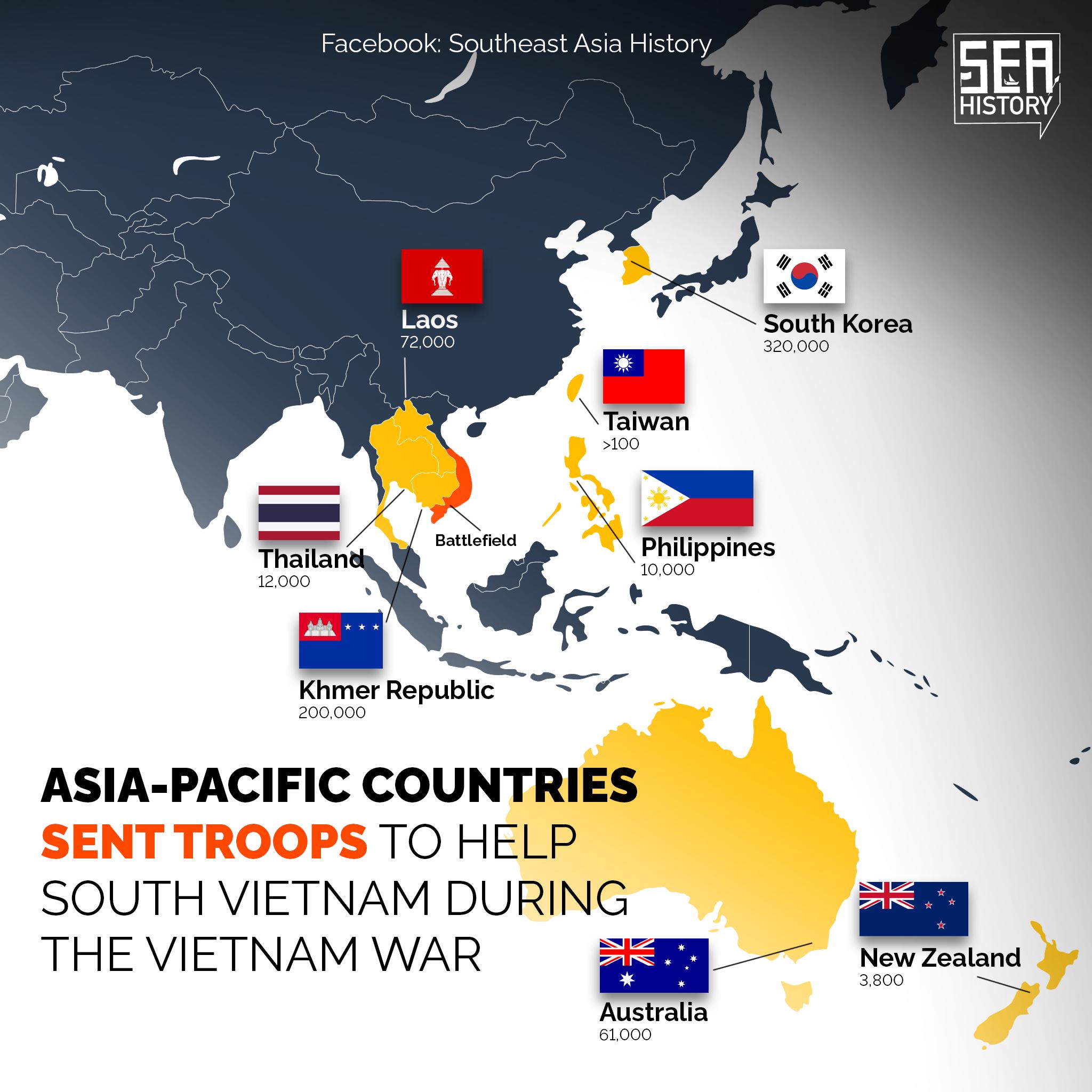Map of Asia Pacific Troops in Vietnam War


Alex Cartwright
Senior Cartographer & GIS Specialist
Alex Cartwright is a renowned cartographer and geographic information systems specialist with over 15 years of experience in spatial analysis and data...
Geographic Analysis
What This Map Shows
This map illustrates the involvement of various Asia Pacific countries that sent troops to support South Vietnam during the Vietnam War, which lasted from 1955 to 1975. The visualization highlights the nations that contributed military forces, showcasing the geopolitical landscape of the region during a tumultuous period in history. Not only does it represent military alliances, but it also serves as a reflection of Cold War dynamics and regional security concerns.
Deep Dive into Troop Contributions During the Vietnam War
The Vietnam War was not just a significant conflict for Vietnam; it also drew in several countries from the Asia Pacific region, each motivated by a mix of ideological, political, and security interests. Countries like South Korea, Thailand, the Philippines, New Zealand, and Australia sent combat troops to support the South Vietnamese government against the communist forces of North Vietnam and the Viet Cong.
Interestingly, South Korea emerged as one of the largest contributors of foreign troops, with approximately 320,000 soldiers deployed over the course of the war. This was a significant commitment, reflecting South Korea's alliance with the United States and its desire to combat the spread of communism in Southeast Asia. The South Korean forces were involved in numerous operations and were known for their fierce combat capabilities, although their presence also sparked controversies regarding human rights violations during their deployment.
The Philippines, another crucial ally, sent around 10,000 troops to assist in the conflict, primarily in non-combat roles, including medical and logistical support. This participation was influenced by the Philippines' long-standing alliance with the United States, as well as the desire to ensure that communism did not spread to the archipelago.
Australia and New Zealand also played significant roles, contributing combat troops as part of their commitment to the Southeast Asia Treaty Organization (SEATO). Australia deployed around 60,000 troops, while New Zealand sent about 3,500. Their involvement was rooted in both defense agreements and a shared commitment to contain communism in the region. The experience of Australian and New Zealand forces in Vietnam not only shaped their military strategies but also influenced their domestic politics in the years following the war.
Interestingly, the war had profound implications for these countries, leading to protests and political upheaval as public sentiment turned against the conflict. This shift in public opinion often resulted in a reevaluation of their foreign policies and military engagements in subsequent decades.
Regional Analysis
When examining the contributions of these Asia Pacific nations, it's essential to consider regional dynamics and the varying motivations behind troop deployments. For instance, South Korea's significant troop contribution was largely driven by the threat of communism, not only in Vietnam but also as a lingering concern in their own country, still divided by war with North Korea. This historical context underscores the interconnectedness of regional security concerns during the Cold War era.
Conversely, Australia's involvement was influenced by its geographical distance from Vietnam and the strategic importance of Southeast Asia to its national security. The Australian government's decision to send troops was also shaped by its alignment with US foreign policy, reflecting broader Western interests in the region.
Thailand, geographically closer to Vietnam, also contributed troops, primarily as part of a broader strategy to secure its own borders and maintain its sovereignty amidst the spread of communism. The Thai government viewed the conflict as a critical front in the fight against communism that could have direct ramifications for its own political stability.
Significance and Impact
The involvement of Asia Pacific countries in the Vietnam War has had lasting implications on international relations in the region. This conflict not only shaped military engagements and foreign policy decisions but also affected domestic politics, public sentiment, and international alignments for years to come. The legacy of the Vietnam War is still felt today, as countries in the Asia Pacific continue to navigate their roles in regional security and international diplomacy.
Moreover, the Vietnam War serves as a reminder of the complexities of international alliances and the multifaceted nature of military engagements. As new geopolitical challenges arise, understanding the historical context of troop deployments during the Vietnam War can inform contemporary discussions about military interventions and alliances. Ever wondered how the lessons learned from such conflicts might impact current military strategies in the Asia Pacific? The answer lies in the intricate tapestry of history that continues to shape our world today.
Visualization Details
- Published
- September 16, 2025
- Views
- 76
- Tags
Comments
Loading comments...